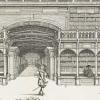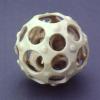Ordinary visitors: evidence of handling
Commentary
PRESCRIBED SOURCES
‘One could wish that the catalogues or indices, bad as they are, were published, …. The specimens of the museum might also be much better arranged and preserved, …. But it is surprising that things can be preserved even as well as they are, since the people impetuously handle everything in the usual English fashion and, as I mentioned before, even women are allowed up here for sixpence; they run here and there, grabbing at everything and taking no rebuff from the Sub-Custos.’
W.H.Quarrel and W.J.C. Quarrel, eds., Oxford in 1710 from the Travels of Zacharias Conrad von Uffenbach (Oxford, 1928), p. 31.
'Nott long after [visiting Tradescant's Ark in Lambeth] I went to the Tower of London, where I saw a Unicorns horne, about 1½ yards in length and 2 or 2½ Inches diameter att the bigger end, goeinge Taperwise and wreathed, although somewhat smoothe (I thinck by often handlinge). It was white, resemblinge the substance of an Eliphants Tooth, estimated att 18 or 20000 pounds Sterlinge.’
Peter Mundy, ‘Some Observations since my Arrivall Home from India', 1634
Image 1. The clearest evidence of the kind of rough handling described by Mundy and von Uffenbach is described in the chapter on 'Floorboard Archaeology' in J. A. Bennett, S. A. Johnston, and A. V. Simcock, Solomon's House in Oxford: New Finds fromm the First Museum (Oxford, 2000), pp. 59-82.
When floorboards in the upper level of the Old Ashmolean were raised for maintenance in 1999, the detritus recovered included several small ivory objects, including 'a beautiful relief carving of foliage in yellow ivory, less than an inch in diameter, like a cameo or brooch, though it is actually neither (Fig. 78)' (p. 60), which had presumably broken off and fallen through a crack in the floorboards after being dropped by a careless visitor.
Other fragments recovered include the tail and back legs of a lizard, the centre and single surviving leg of a small starfish (pp. 59-60, Fig. 79), and the remains of a fan (whether from a display or a visitor is unknown). A silver coin from Pope Innovent XII, dated 1692 (p. 59 and Fig. 76), was probably also from the collection. A clay marble (Fig. 84) seems to bear witness to a distracted child playing while parents amused themselves with the collections.
Open to visitors of all social stations, the interior of the Ashmolean Museum looked very different from the collections of Imperato, Calceolari, and Worm. Ten lost or discarded key tags (Figs. 99, 100, 101) serve as reminders that 'much of the collection at this period was not on open display but kept in closed cabinets, which had to be unlocked, opened and "shown" to visitors by the assistants. There were probably very few, if any, display cases in the modern sense, except those which covered larger individual objects such as ship models and zoological specimens' (pp. 61-2). It was to pay these assistants that an entrance fee was charged. Unsurprisingly, contemporary English coins also slipped between the floorboards (Figs. 73-75).
'Present in the greatest quantity [amongst the detritus recovered from beneath the floorboards] are scraps of paper, fragments of the shells of nuts (hazelnuts in the most part), fruit stones (mainly of cherries), and stalks and leaves from both the latter (Fig. 80). What we have here (leaving aside the paper) is an insight into the dietary habits of someone in the old Museum, as well as into the between-meals presursors of crisps and chocolate bars' (p. 59).
Image 2. Amongst the most vulnerable objects in the original Ashmolean collection may have been the multiple ivory balls, of the kind pictured elsewhere. There were several such objects in the original Ashmole bequest; and clumsy attempts to turn the inner balls enclosed within the outer ones might well have resulted in the damage caused to this example.
Image 3. Another likely casualty of careless handling is this lead plaquette of the crucifixion, originating in Northern Italy c. 1530-50. The entry on this object in the catalogue of Renaissance sculpture in the Ashmolean suggests that it has suffered repeated wear and tear: ‘Wear to highpoints. Figure of Christ lost. Probably another missing figure at lower right. Central cross broken at lower hole. Bent at top left. Nose of horse at extreme left cut off. Other damage to heads of figures. Small hole towards bottom.’* It seems unlikely that Ashmole would have given it to the University, or that the University woiuld have bothered to retain it, if it were already in this condition. A more likely supposition is that the movable pieces attracted handling which soon broken the soft metal.
The pair of precious Molyneux globes (1592), purchased at great expense by Thomas Bodley, were also rapidly ruined through overuse by both learned and unlearned visitors to the Bodleian.
* Quoting Jeremy Warren, Medieval and Renaissance Sculpture in the Ashmolean Museum, Vol. 3: Plaquettes (Oxford: Ashmolean Museum Publications, 2014), pp. 943-4, no. 409.


